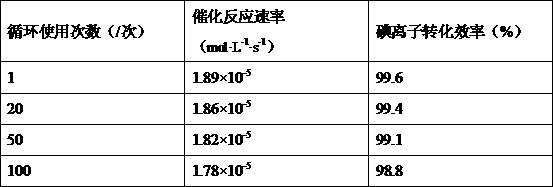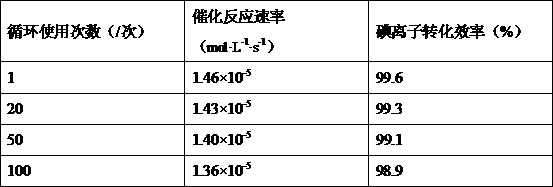Solid carbon-based germanium-molybdenum heteropolyacid catalyst and application thereof
A technology of heteropoly acid and solid carbon, applied in the field of catalysis, can solve the problems of poor recovery, high cost, low catalytic efficiency, etc., and achieve the effects of simple preparation method, easy recovery and improved catalytic performance
- Summary
- Abstract
- Description
- Claims
- Application Information
AI Technical Summary
Problems solved by technology
Method used
Image
Examples
Embodiment 1
[0020] Catalyst preparation:
[0021] Put 1.000g of activated carbon and 5ml of o-carboxyphenylacetic acid solution in a dilute acid solution with a pH of 3 prepared by sulfuric acid, add 0.2g of Keggin type germanium-molybdenum heteropolyacid, 1ml of N,N-dimethylformamide, and Magnetically stirred for 24 hours, then ultrasonically oscillated for 1 hour, moved into a hydrothermal reaction kettle, and used a temperature-programmed oven to raise the reaction temperature from room temperature to 150 °C within 1 hour, and maintained the temperature for 48 hours, and then naturally cooled to room temperature. Rinse several times with ultrapure water and ethanol, filter, and dry for 12 hours to obtain samples for later use.
[0022] Catalyst evaluation:
[0023] (1) The catalyst embodiment:
[0024] Dissolve 1.6667g of potassium iodide in an appropriate amount of deionized water, transfer it to a 100mL volumetric flask, and adjust the volume to 0.01mol / L iodine solution, take 10mL...
Embodiment 2
[0038] Catalyst preparation:
[0039] Put 1.000g of activated carbon and 5m of o-carboxyphenylacetic acid solution in a dilute acid solution with a pH of 3 prepared by sulfuric acid, add 0.2g of Keggin type germanium molybdenum heteropolyacid, 1ml of N,N-dimethylformamide, 0.041g Ferrous sulfate, magnetically stirred at room temperature for 24 hours, then ultrasonically oscillated for 1 hour, moved into a hydrothermal reaction kettle, and used a temperature-programmed oven to raise the reaction temperature from room temperature to 150°C within 1 hour, and kept the temperature for 48 hours, and then Naturally cool down to room temperature, wash with ultrapure water and ethanol several times, filter, and dry for 12 hours to obtain samples for later use.
[0040] Catalyst evaluation:
[0041] Dissolve 1.6667g of potassium iodide in an appropriate amount of deionized water, transfer it to a 100mL volumetric flask, and adjust the volume to 0.01mol / L iodine solution, take 10mL of i...
Embodiment example 3
[0045] Catalyst preparation:
[0046] Put 1.000g of activated carbon and 5ml of o-carboxyphenylacetic acid solution in a dilute acid solution with a pH of 3 prepared by sulfuric acid, add 0.2g of Keggin type germanium molybdenum heteropolyacid, 1ml of N,N-dimethylformamide, 0.0456g Zinc sulfate, magnetically stirred at room temperature for 24 hours, then ultrasonically oscillated for 1 hour, moved into a hydrothermal reaction kettle, and used a temperature-programmed oven to raise the reaction temperature from room temperature to 150°C within 1 hour, and kept the temperature for 48 hours, and then naturally Cool down to room temperature, rinse with ultrapure water and ethanol several times, filter, and dry for 12 hours to obtain samples for later use.
[0047] Catalyst evaluation:
[0048] Dissolve 1.6667g of potassium iodide in an appropriate amount of deionized water, transfer it to a 100mL volumetric flask, and adjust the volume to 0.01mol / L iodine solution, take 10mL of i...
PUM
 Login to View More
Login to View More Abstract
Description
Claims
Application Information
 Login to View More
Login to View More - R&D
- Intellectual Property
- Life Sciences
- Materials
- Tech Scout
- Unparalleled Data Quality
- Higher Quality Content
- 60% Fewer Hallucinations
Browse by: Latest US Patents, China's latest patents, Technical Efficacy Thesaurus, Application Domain, Technology Topic, Popular Technical Reports.
© 2025 PatSnap. All rights reserved.Legal|Privacy policy|Modern Slavery Act Transparency Statement|Sitemap|About US| Contact US: help@patsnap.com



